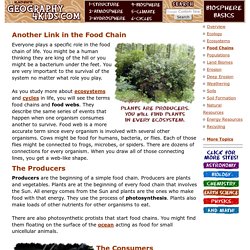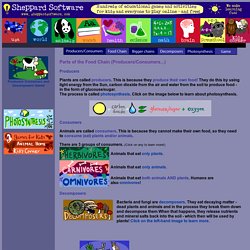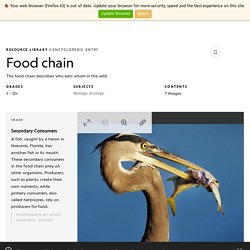

Welcome to the Food Chains Collection! Fabulous Food Chains: Crash Course Kids #7.1 (A Fun Video that Gives an Introduction to the Concept of Food Chains) Food Chains: StudyJams! Science (An Information Video About Food Chains Including Key Vocabulary) Biosphere: Food Chains (An Informational Overview on Food Chains) Everyone plays a specific role in the food chain of life.

You might be a human thinking they are king of the hill or you might be a bacterium under the feet. You are very important to the survival of the system no matter what role you play. As you study more about ecosystems and cycles in life, you will see the terms food chains and food webs. They describe the same series of events that happen when one organism consumes another to survive. Food web is a more accurate term since every organism is involved with several other organisms. Producers are the beginning of a simple food chain. There are also photosynthetic protists that start food chains. Consumers are the next link in a food chain. Secondary consumers eat the primary consumers. In some ecosystems, there is a third level of consumer called the tertiary consumer (that means third level). There are also consumers called omnivores.
The last links in the chain are the decomposers. Or search the sites for a specific topic. Food Chains Summary/Overview. The Food Chain Every living thing needs energy in order to live.

Everytime animals do something (run, jump) they use energy to do so. Animals get energy from the food they eat, and all living things get energy from food. Plants use sunlight, water and nutrients to get energy (in a process called photosynthesis). Energy is necessary for living beings to grow. A food chain shows how each living thing gets food, and how nutrients and energy are passed from creature to creature. A simple food chain could start with grass, which is eaten by rabbits. Producers and Consumers Information. Parts of the Food Chain (Producers/Consumers...)

Producers Plants are called producers. This is because they produce their own food! They do this by using light energy from the Sun, carbon dioxide from the air and water from the soil to produce food - in the form of glucouse/sugar. The process is called photosynthesis. Consumers. Carnivore Information. Herbivore Information. Omnivore Information. Decomposers Information. Real-life Food Chain Images and Examples. The food chain describes who eats whom in the wild.

Every living thing—from one-celled algae to giant blue whales—needs food to survive. Each food chain is a possible pathway that energy and nutrients can follow through the ecosystem. For example, grass produces its own food from sunlight. A rabbit eats the grass. A fox eats the rabbit. Of course, many different animals eat grass, and rabbits can eat other plants besides grass. Trophic Levels Organisms in food chains are grouped into categories called trophic levels. Producers, also known as autotrophs, make their own food. Plants are the most familiar type of autotroph, but there are many other kinds. The second trophic level consists of organisms that eat the producers.
Consumers can be carnivores (animals that eat other animals) or omnivores (animals that eat both plants and animals). Detritivores and decomposers are the final part of food chains. Decomposers like fungi and bacteria complete the food chain. Producers, Consumers and Decomposers Game - Kid's Corner.